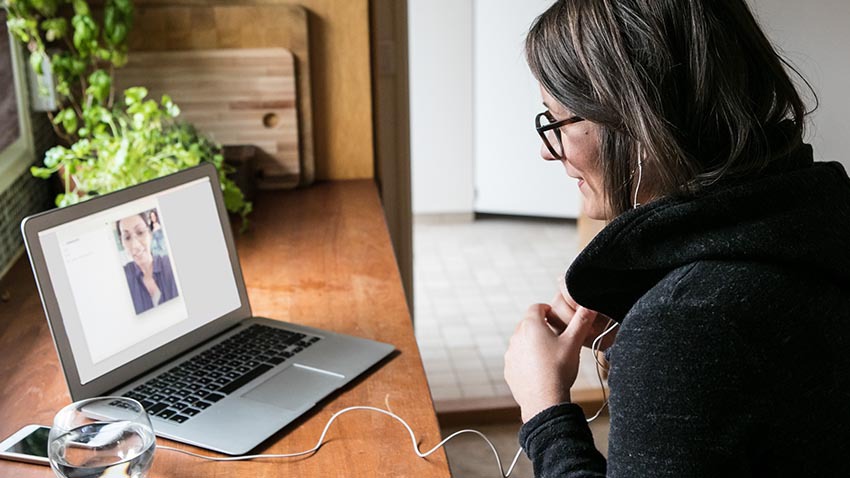The COVID-19 pandemic has substantially changed many aspects of life, including how psychiatrists and other mental health professionals treat rising numbers of patients. With teletherapy quickly becoming the new standard, the minimal clinical evidence supporting its effectiveness is a growing concern.
A national group of psychiatrists and physicians, led by psychiatrist John Markowitz at Columbia University, explores this gap alongside the drawbacks and difficulties of remote psychotherapy. They write:
“At least in the United States, COVID-19 has changed the long-standing requirement that therapists see patients in person. This may well change the face of psychotherapy and enhance the ongoing use of teletherapy, whether or not it is an optimal approach. Our experience to date suggests that in-person psychotherapy, now necessarily in limbo, has many advantages over remote treatment and should eventually return.”

Mental health professionals across the board seem to agree that patient access to clinicians is better than no access, even if this means sacrificing the benefits of in-person therapy for the lesser understood therapy rendered through telephone or video. With mental health challenges surfacing in new ways across the globe and recent studies showing that nearly two-thirds of surveyed psychologists in the United States are performing all of their clinical work remotely, the pandemic is altering therapeutic practices at a much faster pace than supporting clinical evidence for its effectiveness.
A review of clinical evidence supporting different teletherapy modes shows scant evidence of the benefits of these shifts and even less discussion of the trade-offs involved. The authors aim to provide a more nuanced appreciation of teletherapy’s strengths, weaknesses, and clinical issues through their recent practice-based observations.
Much reported “teletherapy” is not tele-psychotherapy, and studies reported in reviews more frequently document heterogeneous outcomes rather than traditional efficacy trials. A 2008 meta-analysis found that telephone therapy significantly reduced depressive symptoms across 12 trials (mean effect size, d=0.81 in pre- to post-treatment reduction in symptoms), with a low mean attrition rate of 7.6%. However, many telephone interventions have not been able to reduce depressive symptoms more than controls.
Evidence for individual and group video therapy’s efficacy is even harder to come by, with studies informed by very small sample sizes with an equally large range of effect sizes. Many of these studies comprise mixed diagnoses and treatment types, making comparisons difficult. Nevertheless, studies tend to find equivalent outcomes for in-person and video-rendered CBT. One comparison of telephone-administered and in-person group CBT-focused stress management yielded a large effect size for in-person treatment and a medium one for phone-administered treatment of patients who have Chronic Fatigue Syndrome.
Scattered trials published on the very poorly developed group video-therapy have shown “six randomized trials of differing approaches and disorders suggesting feasibility and roughly comparable outcomes between in-person and tele-group treatments.” However, most of these studies were insufficiently powered to test noninferiority.
Moreover, therapists’ lack of comfort treating high-risk, severely symptomatic patients remotely has limited studies to non-severe cases. Less ill, teletherapy-enthused patients may skew outcome research toward positive results that assume teletherapy is an adjunct to, or augmentation of, in-person care.
Distance illuminates new issues for practitioners that both expand and constrain the therapeutic relationship. Despite teletherapy advocates’ claims that remote therapy expands access to more Americans, many at-risk populations, like the poor and elderly, lack high-speed Internet access. Even fewer have access to the private space required for teletherapy.
This underlies the authors’ anecdotal remarks about the downsides of nonclinical settings: patients and providers are distracted, limited in their use of nonverbal communication, conditioned to act certain ways in front of the camera, and less able to exercise control about what their settings reveal. Both parties’ physical discomfort, loss of affective nuance and emotional engagement, and technical difficulties also hamper sessions in profound ways. The authors suggest, contrary to popular and insurance companies’ belief, video-therapy, as opposed to therapy over the phone, may have more drawbacks than it does benefits.
Of course, the most extreme confounding variable and driver of new tele-psychotherapy research is the pandemic:
“The pandemic not only evokes new symptoms but functions as a Rorschach test, magnifying aspects of patients’ ongoing inner struggles. People respond to the crisis in varying, idiosyncratic ways. Embarrassing behavioral differences between severely agoraphobic and social phobic patients and “normal people” have temporarily shrunk. Some depressed patients have become more depressed, whereas others say that the crisis has led them to downgrade their previous concerns—that COVID-19 has been de-catastrophizing, as it were.”
While teletherapy undoubtedly provides the crucial social link of psychotherapy times of unprecedented difficulty, physical distancing, and deep emotional need, outcome literature is limited and has unclear generalizability relative to in-person therapy. This is especially the case for patients with ‘serious psychiatric problems.’
The scattered, relatively sparse, and selective research literature does not suffice to support the extent to which remote and teletherapy is currently used. The authors hope that clinical research funding will be redirected from neuroscientific pursuits to the more immediate need for rigorous clinical research on the use of different modalities and types of teletherapies for the broader range of psychiatric patients.
****
Markowitz, J. C., Milrod, B., Heckman, T. G., Bergman, M., Amsalem, D., Zalman, H., … & Neria, Y. (2020). Psychotherapy at a Distance. American Journal of Psychiatry, appi-ajp. (Link)















“At least in the United States, COVID-19 has changed the long-standing requirement that therapists see patients in person. This may well change the face of psychotherapy and enhance the ongoing use of teletherapy, whether or not it is an optimal approach. Our experience to date suggests that in-person psychotherapy, now necessarily in limbo, has many advantages over remote treatment and should eventually return.”
I noticed the word “enhance the ongoing use”. Which in this context means “to increase the use”.
Yet to “enhance” can also mean to intensify, increase, or “further improve the quality, value,” or extent of.
A very sneaky way of using language. And in our every day usage of “enhance”, we usually refer to making something “better”. And in this case, they weasel it in to suggest that “therapy is better”, EVEN though they added “whether or not it is an optimal approach”.
All of these pretentious papers are so laced with BAD language, meant to confuse the reader, or manipulate them. Psychiatry is all about BAD language.
So basically you need an english degree to see the ongoing manipulative messages.
Report comment
I would advise reading William Epstein’s latest book Psychotherapy and the social clinic in the united states soothing fictions and his older book the illusion of psychotherapy.
There is no credible evidence for the effectiveness of any psychotherapy whether face to face computer or whatever – the research system is corrupt the research shockingly poor but the advertising and self interest machine is all powerful.
Report comment
i have been helped by a psychotherapist…
i don’t care what the research says…
and i want face to face therapy ….
Report comment
littleturtle.
Don’t underestimate the power of connection,
power of authentic presence and
that can indeed happen between two people or even groups.
Report comment
A question I ask is what is actually helpful is it ‘psychotherapy’ or human compassion and care? It seems to me the latter is intrinsic to many of us but it has been professionalised, making it seem like only this group of paid trained people can help. When in reality mutual aid could be provided by anyone with the time and resources to care – the trouble is our systems don’t give us much time or resources to care and the values support and promote self interest above everything else.
Report comment